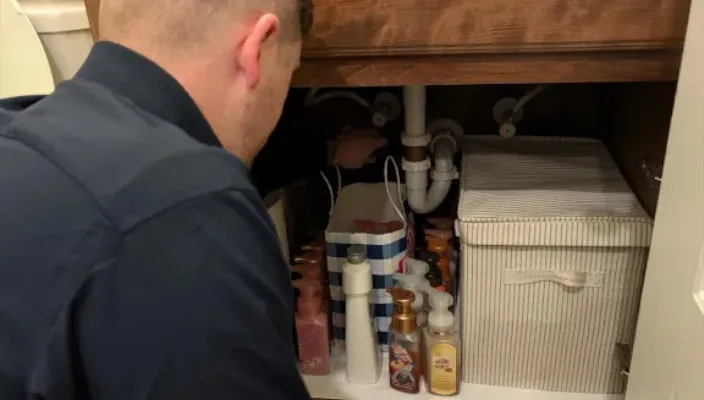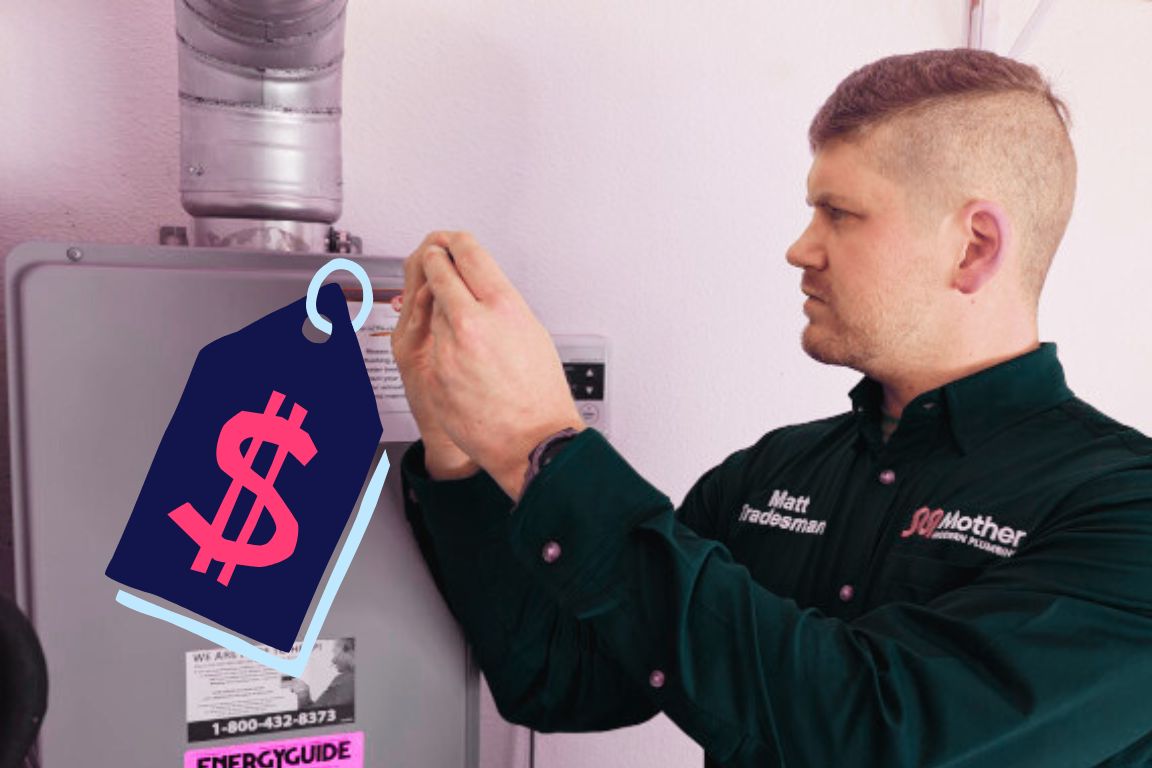Grapevine TX Water Quality Issues: Is It Safe to Drink?

table of contents
table of contents
The current Grapevine, Texas water quality report shows no violations of EPA requirements — but that doesn’t tell the whole story. Residents have a right to be concerned about key contaminants in their tap water.
Grapevine’s water supply matched or exceeded the maximum contaminant level goal (MCLG) for 3 inorganic contaminants, including arsenic and combined radium. It exceeds the recommended standards for limestone, magnesium, sodium and total dissolved solids.
Mother’s DFW plumbing experts strongly suggest installing a whole house water filtration system in Grapevine area homes. We’re licensed and certified to install WaterTech systems, which eliminate heavy metals, herbicides, forever chemicals (PFAS) and hard minerals from your drinking water.
{{whole-home-water-filtration="/services/whole-home-water-filtration"}}
Grapevine Water Sources: Where Do You Get Your Water?

Grapevine’s water supply comes from 2 places — its own water from Lake Grapevine, and purchased water from the Trinity River Association (TRA).
These bodies of water are the sources of all water delivered to Grapevine homes:
- Lake Grapevine
- Lake Arlington (TRA)
- Cedar Creek Reservoir (TRA)
- Richland-Chambers Reservoir (TRA)
Your drinking water passes through several city water treatment plants. It then travels through 328 miles of distribution pipelines before it reaches area homes and businesses.
TCEQ classifies local water contamination risk as “high”
The Texas Commission on Environmental Quality (TCEQ) rates the overall risk for contamination of Grapevine’s source water as high. This means TCEQ believes that human activities near local source water make chemical contamination likely.
Activities in and around the city of Grapevine that may contribute to source water contamination include:
- Manufacturing runoff
- Processing plant wastewater
- Oil and gas drilling
- Electronics production
- Plastics production
What’s In Your Grapevine Tap Water?

Grapevine tap water is safe to drink according to current EPA standards. However, that doesn’t mean it’s 100% free from contaminants and potentially concerning inorganic materials.
The primary materials of concern in the Grapevine water quality report concern hard minerals, chemical contaminants, radiological contaminants, lead and forever plastics (PFAS).
Grapevine has concerning hard water issues
The overall water hardness level of water in Grapevine, Texas is hard to very hard.
There are 3 minerals in North Texas drinking water — limestone, magnesium and calcium. Here’s how they affect water hardness in the Grapevine area:
- Limestone (calcium carbonate): Grapevine has high concentrations of limestone in its water. The local average is 108% the recommended maximum level (109 ppm vs. 101 ppm).
- Magnesium: There is nearly twice as much magnesium in the local tap water than recommended by the federal government (8.12 ppm vs. 4.1 ppm).
- Calcium: Calcium levels are just below the maximum recommended limit, at 38.1 ppm.
These hard minerals cause several plumbing issues for DFW area residents. Mineral scaling in pipes causes slow water flow and poor water pressure, as well as an increased risk for underground pipe leaks and bursts.
Scaling on indoor plumbing fixtures and faucets causes poor flow and inefficient function of appliances. Long-term, untreated scale on water heaters can lead to system malfunction.
{{how-to-remove-calcium-deposits-on-faucets="/blogs/how-to-remove-calcium-deposits-on-faucets"}}
3 chemical and radiological contaminants in Grapevine’s tap water
The City of Grapevine’s most recent water quality report noted 3 inorganic contaminants that exceeded the EPA’s maximum contaminant level goal (MCLG).
While these numbers still fall below acceptable federal standards, they’re not where the EPA wants them to ideally be — which is zero.
In other words: decent, but certainly not good.
These are the 3 chemical and radiological contaminants that exceed the MCLG in Grapevine, Texas:
Arsenic is a naturally occurring element in Texas soil, rocks and water. It enters your water supply through natural erosion — but runoff from local electronics production also causes arsenic contamination.
Arsenic in water is measured in parts per billion (ppb).
Beta/photon emitters are the decay of radioactive atoms. While these radionuclides are found in organic materials, local gas & oil drilling near Grapevine introduces them to the water supply (EPA).
Radium is a radiological contaminant that enters the water supply through erosion of natural deposits. In this report, it’s measured as combined radium types 226 and 228.
Beta/photon emitters and radium in water are measured in picocuries per liter (pCi/L).
Lead and Forever Chemicals: A Work in Progress
Lead – good overall levels, but one designated lead pipe on the chart that was in violation in 2023. Worth monitoring.
{{dallas-water-utilities-lead-pipe-advisory="/blogs/dallas-water-utilities-lead-pipe-advisory"}}
PFAS: The current maximum level of forever chemicals (PFAS) in Grapevine’s water supply exceeds new maximum contaminant level standards set by the EPA.
PFOS and PFOA in water are measured in parts per trillion (ppt).
In an official statement, the City of Grapevine said: “Grapevine’s leadership and water treatment staff are currently working to develop a plan that will meet the EPA’s new PFAS requirements. City will have 5 years to meet these requirements.”
3 Water Treatment Procedures Grapevine Does Well
While mineral hardness and inorganic contaminants are cause for concern, Grapevine’s city council does do a great job at some other water treatment procedures.
Here’s how the city of Grapevine effectively keeps 3 key contaminants out of your water supply:
Chloramines are chlorine-based disinfectants. Grapevine TX water falls well below the maximum contaminant level goal for chloramines in water (2.65 ppm vs. 4.0 ppm). That’s far better than chloramine levels in Fort Worth.
Chromium enters the water supply through steel mill runoff. The chromium level in local water is 99% below the contaminant level goal.
Cyanide leaches into water as discharge from steel, plastic and fertilizer factories. Grapevine’s water supply is currently 90% under the national contaminant level goal.
Clean Water Solutions for Grapevine, TX Residents

If you’re concerned about the overall quality of water delivered to your home in Grapevine, there are 2 simple steps you can take to ensure clean drinking water:
- Home water testing
- Whole house water filter installation
The combined positive impact of residential water testing and home water filtration offers ongoing preventative care for your water supply and plumbing system.
Annual tap water testing protects your family
Residential water testing offers peace of mind at a relatively low cost. A certified local plumbing expert runs a diagnostic analysis of your tap water for key contaminants, hard minerals and heavy metals.
Ask our plumbers about testing your tap water for these contaminants:
- Lead
- Hard minerals (calcium, magnesium, limescale)
- Heavy metals
- PFAS (forever chemicals)
- VOCs (volatile organic compounds)
{{lead-water-test="/services/lead-water-test"}}
Eliminate local contaminants with whole house water filtration
Whole house water filters purify the water that enters your home. They’re installed at the main water line — every tap, faucet, shower and appliance receives clean water.
Home water filtration systems benefit your plumbing system immensely. They reduce sediment and mineral buildup that prevents scaling. This extends the lifespan of your water using appliances and pipe systems, and improves the efficiency of your water heater, dishwasher and washing machine.
Whole home water filters provide internal and external health benefits to users. Filtered water promotes healthier skin and nails while bathing, and minimizes exposure to plastics, pesticides and lead in drinking water.
We trust WaterTech water filtration systems for clean drinking water in Dallas-Fort Worth homes. They’re independently lab certified by IAPMO, the SCC and ANAB for efficiency, sediment and contaminant removal.
WaterTech whole house water filters remove 8 types of contaminants from your water:
- Lead
- Heavy metals
- PFAS, PFOA and forever chemicals
- Chlorine
- Hard minerals
- Pesticides
- Herbicides
- VOCs (volatile organic compounds)
How to Read the Grapevine TX Water Report
The official water report for Grapevine, Texas can be complicated to read, thanks to technical terms and lots of tables to digest.
We’ve simplified the process with this article — including a glossary of key terms that matter to you, simplified data tables and context about what’s really in your drinking water.
Glossary of terms: what the data really means
Here are a few key terms that will help you understand the data in the recent Grapevine, TX Water Quality Report.
Chemical contaminants are contaminants in the water supply from inorganic, chemical sources. In North Texas, these include arsenic, chromium and fluoride.
Contamination levels are taken by the local water authority in regulatory compliance with federal and EPA standards. These are usually listed as minimum, maximum or average levels.
Maximum contaminant level goal (MCLG) is a level of a contaminant in drinking water set by the government. Once contaminant levels reach MCLG, there is no known or expected risk to health.
Maximum contaminant level (MCL) refers to the highest level of a contaminant allowed in drinking water by government standards.
Measurement rate refers to the standard unit of measure that’s used to define the amount of individual contaminants in the water supply. Common contaminant measurement rates include parts per million (ppm) and parts per billion (ppb).
A unique measurement rate, picocuries per liter (pCi/L), is used to measure radioactive contamination in the water supply.
Radiological contaminants are contaminants in water with radioactive properties. In Dallas-Fort Worth, these include beta/photon emitters and radium.
Clean Up Your Water. Gain Peace of Mind.
The current Grapevine water report exposes several key concerns for residents — most notably, the presence of chemical contaminants and high water hardness.
Homeowners can mitigate these issues by scheduling an annual home water test and installing a whole house water filter to deliver purified, clean water to their taps.
Concerned about your water quality? Call Mother about water testing and filtration services — we’d love to answer your questions and provide you peace of mind.
{{whole-home-water-filtration="/services/whole-home-water-filtration"}}




